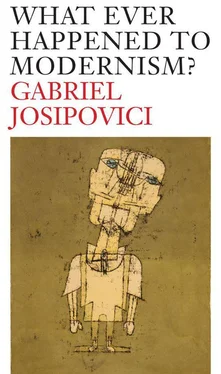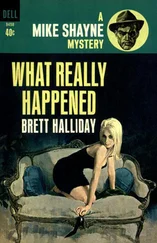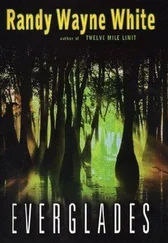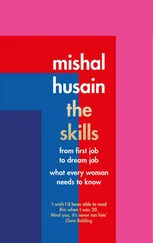Claude Simon, in La Corde raide , had made the same point, more dramatically. In Cézanne we see, he says,
a universe for the first time bereft of all signposts, so totally bereft of everything except for truth and cohesion that for the first time it offered in its total magnificence, with neither commentary nor restriction, the visible world and, through it, the world itself … It was something like the loss of all illusion. The loss of a dreamy and romantic virginity in exchange for a substantial knowledge, at once dazzled and disenchanted.
In traditional landscape the elements making up the scene — trees, hills, houses, sky — had been made visible, as it were, by being placed within a single perspective and given an outline, delineated. Cézanne came to understand, as he obsessively returned to his mountain, day after day, not only that nature does not conform to the laws of perspective set out in the manuals, but also that nature has no edges, that perspective and delineation are for the convenience of the artist who depicts it and the viewer who looks at it. But then what is to be seen? What is seeing itself? For Cézanne that mountain became what the white whale had been for Ahab, an element of the natural world which in time grew into a metaphysical obsession. How to capture it without humanising it, without turning it into an anecdote, ‘that mountain which I, Cézanne, painted one day’? How, in Wallace Stevens's words, ‘to see the earth again/ Cleared of its stubborn, man-locked set?’ how, in Bacon's words, to give it a life on the canvas at least equal to the life it had in actuality? Partly this was a problem of seeing: how to see it as it is and not as I see it? And partly it was a problem of painting: how to mark the transitions from background to foreground, from that which surrounds a tree or mountain to the tree or mountain itself, since in nature there is no such thing as background and foreground? ‘We must render the image of what we see’, Cézanne wrote to a young painter, ‘forgetting everything that existed before us.’
Was it, like Ahab's quest, an ambition doomed to failure? Can any throw of the dice abolish the hazard of the contingent? Had not the traditional method of landscape in effect made the best of an impossible task? Perhaps so, but that did not satisfy Cézanne. And in the process of struggling, isolated and forgotten, with his demon, Cézanne produced a body of work which seemed to certain discerning artists who came after him and sensed what it was he was struggling with, to bring things to a new pitch. In his Bathers in the Barnes Collection, for example, the movements of the bathers seem, to Claude Simon, to have no discernible beginning or end: ‘These almost asexual bodies in motion in an eternity without end and without any other reason than the radiant shimmering of their gestures without beginning or end [ et sans autre raison que l'irradiant frémissement de leurs gestes sans commencement, sans fin ].’ For Francis Bacon, as we have seen, they solved the problem of how to depict more than one figure yet not turn the painting into a story, an anecdote. At the same time, as Merleau-Ponty points out in his great essay, ‘Le Doute de Cézanne’:
It is Cézanne's genius that when the overall composition of the picture is seen globally, perspectival distortions are no longer visible in their own right but rather contribute, as they do in natural vision, to the impression of an emerging order, an object in the act of appearing, organising itself before our eyes [ d'un ordre naissant, d'un objet en train d'apparaître, en train de s'agglomérer sous nos yeux ]. In the same way, the contour of an object conceived as a line encircling the object belongs not to the visible world but to geometry. If one outlines the shape of an apple with a continuous line, one makes an object of the shape, whereas the contour is rather the ideal limit toward which the sides of the apple recede in depth. Not to indicate any shape would be to deprive the objects of their identity. To trace just a single outline sacrifices depth — that is, the dimension in which the thing is presented not as spread out before us but as an inexhaustible reality full of reserves [ non comme étalé devant nous, mais comme pleine de réserves et comme une réalité inépuisable ]. That is why Cézanne follows the swelling of the object in modulated colours and indicates several outlines in blue. Rebounding among these, one's glance captures a shape that emerges from among them all, just as it does in perception.
The agony for Cézanne, the doubt that he constantly feels about the value and even the point of what he is doing, stems from this, that he does not start with a given image, ready-made, but seeks instead to recreate each time the sense we have of the world coming to life as we look at it and live in it. As Merleau-Ponty says:
We live in the midst of man-made objects, among tools, in houses, streets, cities, and most of the time we see them only through the human actions which put them to use. We become used to thinking that all of this exists necessarily and unshakably. Cézanne's painting suspends these habits of thought and reveals the base of inhuman nature upon which man has installed himself. This is why Cézanne's people are strange, as if viewed by a creature of another species.
We have come across this sort of thing before, of course, in Wordsworth. But Wordsworth's intellectual error was to imagine that there was an earlier time in life when the world presented itself in this fashion, and he despaired of ever finding it again once he grew up. Merleau-Ponty's analysis of Cézanne suggests, rather, that this primal time is always there, waiting to be rediscovered by the artist. Of course there is no guarantee that it will be and no clear sense of what it is that is waiting to be rediscovered, but one thing is certain: it has to do with a dialogue between us and the world, a dialogue conducted through the medium of our art (the dialogue we saw taking place between the Boy of Winander and the owls and the poet and the boy). ‘The painter’, says Merleau-Ponty, concluding this part of his essay, ‘recaptures and converts into visible objects what would, without him, remain walled up in the separate life of each consciousness: the vibration of appearance which is the cradle of things.’
Of course, as with Mallarmé, what Cézanne was doing was merely taking a little further what had been a key element in painting since its inception, though, as Bacon suggests in his conversations with David Sylvester, that had been partly hidden (perhaps fortunately, he says) by the many other functions which painting once had. But taking it further, which, to the artist himself, seemed the most natural thing in the world and indeed the only thing worth doing, led to accusations of wilful disregard of the public, to Tolstoy's dismissal of Mallarmé and to charges of deliberate uglification levelled at Cézanne. Ironically, today, over a hundred years after their work appeared, Mallarmé is still considered ‘too difficult’ even by those who make a habit of reading poetry, but reproductions of Cézanne hang on every student wall. One wonders which is the kinder fate.
Cézanne went on being an influence and an inspiration to Claude Simon for all his writing life, and it would be easy to show that his work takes after Cézanne in all sorts of ways: in the sweeping up of the torrent of history into a singular narrative with its singular, compulsive style, which colours the telling and what is told; in its refusal to grant any special status to human and especially moral sentiments, which makes La Route des Flandres in particular so great a war novel; in its ability to create worlds which feel both that they have always existed and that they are only present by virtue of the effort the narrator is making to speak. All this, of course, could also be seen as subscribing to the Mallarméan dictum: ‘Everything happens by means of short cuts, hypothetically; narrative is avoided.’ Which suggests that though there might be a particularly close bond between Simon and Cézanne, it is not so much direct influence we are talking about as the opening up of possibilities by early Modernists. So let us take another writer, very different from Claude Simon, much more sly, much sadder and more comic than him or than Cézanne and Mallarmé, but equally anxious to escape the arbitrariness of conventional narrative, its ready-made quality. Let us look at the opening page of Robert Pinget's 1969 novel, Passacaille :
Читать дальше












